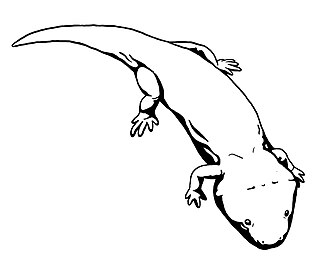Related Research Articles

Deltasaurus is an extinct genus of Carnian temnospondyl amphibian of the family Rhytidosteidae.
Rhytidosteoidea is a superfamily of Temnospondyli, early amphibian species that existed during the Carboniferous, Permian, and Triassic periods. The taxon was established in 1965 to accommodate two new species of Deltasaurus, the author recognising an alliance with previously described genera.
Almasaurus is an extinct genus of trematosaurian temnospondyl within the family Latiscopidae. It is known from several skulls and some postcranial material found from the Argana Formation in Morocco, which dates back to the Late Triassic.
Bothriceps is an extinct genus of stereospondyl temnospondyl. It is a member of the infraorder Trematosauria and is the most basal brachyopomorph known. It is one of the only brachyopomorph that lies outside the superfamily Brachyopoidea, which includes the families Brachyopidae and Chigutisauridae. It shares several similarities to Keratobrachyops, another basal brachyopomorph, and may be closely related to or even synonymous with it.
Blinasaurus is a name of an extinct genus of prehistoric brachyopid found in Triassic geological formations of Australia. The type species is Platyceps wilkinsonii Stephens, 1877. The genus was established by John W. Cosgriff in 1969 to incorporate the type, discovered in New South Wales, and the author's new fossil species, Blinasaurus henwoodi, describing type material found in Blina Shale in the Kimberley region of northwest Australia.

Banksiops is an extinct genus of temnospondyl amphibian in the family Brachyopidae, recovered from Tasmania.

Indobrachyops is an extinct genus of temnospondyl amphibian from the Early Triassic of India. It is known from a nearly complete fossil skull that was first described by paleontologists Friedrich von Huene and M. R. Sahni in 1958 from the Panchet Formation in Raniganj Coalfield. Indobrachyops belongs to a group of mostly semi-aquatic temnospondyls called Stereospondyli, but its exact placement within the group has been uncertain since its first description.
Gobiops is an extinct genus of temnospondyl from the Jurassic of Mongolia, China, and possibly Kyrgyzstan. The genus is represented by a single species, Gobiops desertus. It was named in 1991 from the Late Jurassic Shar Teeg Beds of Mongolia. Additional material was described in 2005 from the Middle Jurassic Toutunhe Formation in the Junggar Basin of China. Gobiops belongs to the family Brachyopidae. The poorly known genus Ferganobatrachus, named in 1990 from Shar Teeg, is probably synonymous with Gobiops.
Keratobrachyops is an extinct genus of trematosaurian temnospondyl found in the Arcadia Formation of Queensland, Australia. It had been thought to be a basal chigutisaurid but is now thought to be a basal brachyopomorph closely related to the genus Bothriceps, and may even be a synonym of it.

Platycepsion wilksoni is an extinct species of prehistoric amphibian, known from partial skeleton deposited in shale at the Gosford Quarry site of the Terrigal Formation in Australia.
Plagiobatrachus is an extinct genus of plagiosaurid temnospondyl. It is known from the Rewan Formation, an Early Triassic formation in Australia.
Thabanchuia is an extinct genus of dvinosaurian temnospondyl within the family Tupilakosauridae. It is known from the Lystrosaurus Assemblage Zone in Thaba N'chu, Free State, South Africa. The genus contains just one species, Thabanchuia oomie, the type species.

Abraxas, the magpie moths, is a genus of moths in the family Geometridae. It was first described by William Elford Leach in 1815.

Cyclophora is a genus of moths in the family Geometridae. Many species are referred to as mochas in reference to their colouration, primarily in Europe.

Sterrhinae is a large subfamily of geometer moths with some 3,000 described species, with more than half belonging to the taxonomically difficult, very diverse genera, Idaea and Scopula. This subfamily was described by Edward Meyrick in 1892. They are the most diverse in the tropics with the number of species decreasing with increasing latitude and elevation.
Meruidae is a family of aquatic beetles in the suborder Adephaga, with only one genus and species, Meru phyllisae. The beetle species was first found in the early 1980s. and fully described in 2005. At 0.8 mm (0.031 in), it is one of the smallest adephagan beetles in the world. A survey of aquatic beetles of Venezuela indicated that Meru is most common during the wet season, when larger areas of granitic rock surface are covered with water film, which the adult beetles as well as the larvae inhabit.

Herculia is a genus of moths belonging to the family Pyralidae. The genus is mostly treated as a synonym of Hypsopygia. If considered valid, some species previously placed here are now in Dolichomia and Ocrasa, which in turn are also mostly merged in Hypsopygia. O. fulvocilialis is sometimes still placed in the present genus.

Asthenini is a tribe of geometer moths under subfamily Larentiinae first described by Warren in 1893. The tribe has been combined with Eupitheciini in the past, most notably by Jeremy Daniel Holloway in his work The Moths of Borneo.

Vigilius is an extinct genus of brachyopid temnospondyl amphibian from the Triassic of Arizona. It is known from the single type species Vigilius wellesi.
References
- Amnesicoma at Natural History Museum genus database
- Amnesicoma at Markku Savela's Lepidoptera and some other life forms